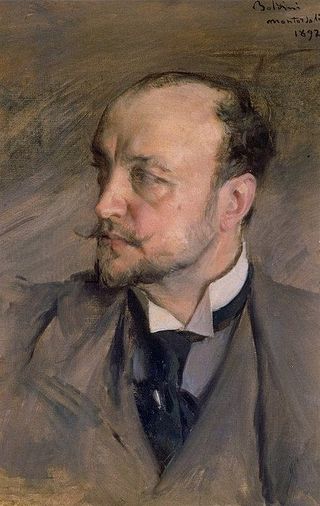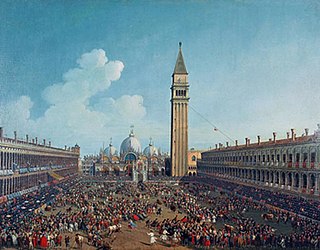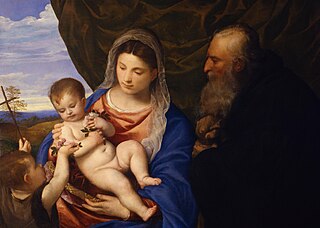
Giambattista Pittoni or Giovanni Battista Pittoni was a Venetian painter of the late Baroque or Rococo period. He was among the founders of the Academy of Fine Arts of Venice, of which in 1758 he became the second president, succeeding Tiepolo.

Giovanni Boldini was an Italian genre and portrait painter who lived and worked in Paris for most of his career. According to a 1933 article in Time magazine, he was known as the "Master of Swish" because of his flowing style of painting.

Giovanni Battista Cimaroli (1687–1771) was an Italian painter of rustic landscapes with farms, villas and graceful figures and capricci of ruins and views of towns in the Veneto.

The Procession in St. Mark's Square is a tempera-on-canvas painting by Italian Renaissance artist Gentile Bellini, dating from c. 1496. It is housed in the Gallerie dell'Accademia in Venice.
Walter Noetico is an Italian painter, sculptor, and writer. He is the founder of two art movements: Indimensionalism and Neoilluminism. He is also the inventor of new artistic techniques and of the new Alphabet, Neoilluminist Alphabet, in which every letter has a symbol of a woman and a man.

The Pesaro Altarpiece is an oil-on-panel painting by the Italian artist Giovanni Bellini, dated to some time between 1471 and 1483. It is considered one of Bellini's first mature works, though there are doubts on its dating and on who commissioned it. The work's technique is not only an early use of oils but also of blue smalt, a by-product of the glass industry. It had already been used in the Low Countries in Bouts' 1455 The Entombment, but this marked smalt's first use in Italian art, twenty years before Leonardo da Vinci used it in Ludovico il Moro's apartments in Milan in 1492. Bellini also uses the more traditional lapis lazuli and azurite for other blues in the work.

Pietà or The Dead Christ Supported by the Virgin Mary and St John the Evangelist is a c. 1465–1470 tempera-on-panel painting by the Italian Renaissance artist Giovanni Bellini, now in the Pinacoteca di Brera in Milan.

Baptism of Christ is a tempera painting on panel by the Italian Renaissance master Giovanni Bellini, dating to 1500–1502, and now located in the Chiesa di Santa Corona in Vicenza. It is signed IOANNES / BELLINVS on a rock in the lower left.

The Madonna and Child with St. John the Baptist and a Female Saint or the Giovanelli Sacred Conversation is an oil painting on panel by the Italian Renaissance master Giovanni Bellini, dated to before 1504. It is kept in the Gallerie dell'Accademia of Venice.

Tiziano Panconi is an Italian art historian, specializing in Italian painting of the eighteenth century, in particular of Macchiaioli and Giovanni Boldini

Portrait of a Knight of Malta is a c.1515 oil on canvas painting by Titian of a knight belonging to the Order of Malta. It is now in the Uffizi in Florence. The last bead of the rosary held by the knight bears the number XXXV (35), showing the subject's age at the time of the portrait. W.F. Dickes. argued that he was Stefano Colonna, the condottiero who led the republican resistance during the siege of Florence. cited in

Madonna of the Roses is a c.1530 oil on panel painting by Titian, now in the Uffizi in Florence. As well as the Madonna and Child it also shows Anthony the Great. and a young John the Baptist. It is signed "Ticianus f.", but this may be a later addition.

St Anthony of Padua with Two Saints is a c. 1530 oil on canvas painting by Moretto da Brescia, now in the Pinacoteca Tosio Martinengo in Brescia. The other two saints shown are Antony the Great and Nicholas of Tolentino.

Minerva between Geometry and Arithmetic is a fresco fragment, usually attributed to Paolo Veronese, from 1550, but by some art historians to Anselmo Canera or Giambattista Zelotti. It was painted for the Palazzo de Soranzi in Castelfranco Veneto but is now in the Palazzo Balbi, in Venice.

Mystic Marriage of Saint Catherine or Mystic Betrothal of Saint Catherine is a c.1524 oil on canvas painting by the Italian Renaissance painter Parmigianino. The work is now in the Galleria nazionale di Parma. Art historians argue that the work may be attributed to the period in which Parmigianino was painting his first works in the church of San Giovanni Evangelista, as also emerges from a recent restoration, which has shown that its technique is near-identical to that of Parmigianino - "no underdrawing, pigment use, descriptive speed, drafting of final shadows, using fingers and brush-ends as tools".

Self-Portrait Aged 71 is an 1862 oil-on-canvas painting by the Italian artist Francesco Hayez. The Uffizi had been requesting a self-portrait from him since 1858 via Andrea Appiani's daughter-in-law Giuseppina Appiani Strigelli and it finally arrived in 1863. It is still in the Uffizi's Vasari Corridor.

Renzo Eusebi, Italian painter, sculptor of contemporary art. He is co-founder of the artistic movements of Transvisionismo (1995) and GAD.

Portrait of Lionello d'Este is a c.1441 tempera on panel painting by Pisanello, now in the Accademia Carrara in Bergamo. The work was recorded in the Costabili collection in Ferrara in 1841.

Holy Family with the Infant Saint John the Baptist and Saint Mary Magdalene is a 1508–1512 oil-on-panel painting by the Venetian painter Palma Vecchio. It was in archduke Leopold William of Austria's collection in Brussels from 1653 to 1662 before being moved to the Imperial Galleries in Vienna, before finally being exchanged for another work with the Uffizi in Florence in 1793, where it is now inventory number 950.


















